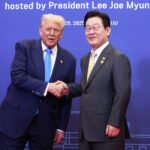
The South Korean won rebounded sharply from seven-month lows on Friday morning after authorities moved to steady the currency with a mix of verbal warnings and suspected dollar-selling. The won strengthened to around 1,450 per dollar in morning trading, recovering from the mid-1,470 range seen earlier in the day.
Deputy Prime Minister and Finance Minister Koo Yun-cheol said after a market-monitoring meeting earlier Friday that policymakers were increasingly concerned about the won’s slide, citing the impact of Koreans’ rising overseas investments on foreign-exchange supply and demand.
“There was broad agreement on the need for structural improvements in the foreign-exchange balance,” Koo said.
He warned that if the imbalance persists, expectations of a weaker won could become entrenched among market participants, “significantly constraining the currency’s downward movement.”
Authorities, he added, agreed on the need to “actively use available policy tools” to stabilize the market.
The ministry said FX and financial regulators will analyze the drivers of the won’s weakness and work with major market participants, including the National Pension Service and large exporters, to prepare stabilization measures.
Koo’s remarks marked the government’s first clear verbal intervention since October, and the impact was immediate.
The won strengthened to 1,455.9 per dollar from 1,475.4 in Seoul’s onshore market. The dollar-won pair opened at 1,471.9, briefly climbed to 1,474.9, and then broke above 1,475 before retreating.

FX analysts said investors welcomed the comments because the won had weakened far beyond what fundamentals would justify, driven largely by supply-demand distortions rather than economic deterioration.
They expect authorities to reinforce the upper end of the won’s trading range through coordinated efforts with major FX players such as Korea’s largest institutional investor and state pension fund, NPS, and big exporters, potentially through institutional adjustments.
SUSPECTED DOLLAR-SELLING ADDED FORCE
FX traders said the rebound appeared too sharp to be driven by verbal intervention alone, pointing to possible smoothing operations, which is targeted, small-scale dollar-selling by authorities to counter disorderly moves.
“There were signs of actual intervention around the comments,” said one senior currency dealer at a local bank.
Even so, analysts said Friday’s recovery does little to alter a broader backdrop of dollar strength, geopolitical uncertainty and cautious risk sentiment.
The government’s pre-emptive move, they added, likely reflected worries that the won could break above 1,480 without stronger policy signals.
This week, the won breached the 1,470 level, slipping to its weakest point since April 9, when the exchange rate hit 1,484.1 amid rising US-China tensions.
The currency has returned to levels last seen during the bout of political turmoil triggered by then-President Yoon Suk Yeol’s brief declaration of martial law.
HEAVY FOREIGN KOSPI SELLING, JAPANESE PM’S COMMENTS

Analysts attributed the weaker won to heavy foreign selling in the Kospi as global investors booked profits after several months of gains in Korean equities.
Persistent dollar demand from retail investors buying overseas assets, including US tech stocks, has also added pressure.
The won is trading near levels recorded in December 2024, when political unrest surrounding the martial-law declaration pushed the exchange rate as high as 1,442 on Dec. 3.
It remained between 1,410 and 1,480 per dollar for about five months before strengthening into the 1,300 range in May.
The currency has now spent 31 consecutive trading days above 1,400 per dollar. Economists in Seoul say the won could approach 1,500 by year-end if current trends persist.
The won traded at 1,459.5 per dollar shortly before noon on Friday.















